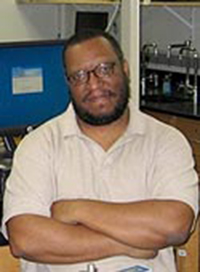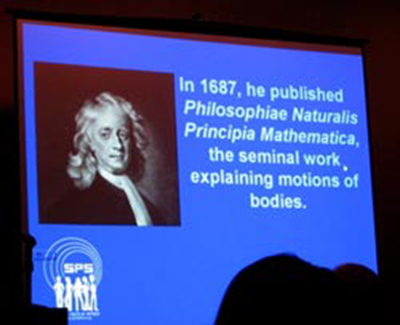By Ernest P. Stewart, Jr., Robert Jones and Suman Khatiwada, Morgan State University, Baltimore, MD
Comments by Ernest P. Stewart, Jr., Physics senior
 From university professors and graduate students to high school teachers (my own probable career path) one theme stood out: How do we teach better?
From university professors and graduate students to high school teachers (my own probable career path) one theme stood out: How do we teach better?
I went down to our city’s Inner Harbor Sunday evening and attended the SPS/AAPT poster reception and Physics Jeopardy competition. Who says physicists cannot have a good time? The posters by many undergraduate and graduate students were a view into twenty-first century education and research. Our own Suman Khatiwada presented a research poster and tells about it below.
 The Jeopardy competition was an exercise in well-known facts as well as little known trivia. One of the questions was “How many PhDs in Physics have been given to African-American women?” The shocking answer was “50.” When I went around asking people at the conference about this phenomenon, I met a woman working towards her own PhD and becoming the 51st. One of the greatest aspects of a conference of this type is the ability to interact with people already in the field and those at the threshold of their careers.
The Jeopardy competition was an exercise in well-known facts as well as little known trivia. One of the questions was “How many PhDs in Physics have been given to African-American women?” The shocking answer was “50.” When I went around asking people at the conference about this phenomenon, I met a woman working towards her own PhD and becoming the 51st. One of the greatest aspects of a conference of this type is the ability to interact with people already in the field and those at the threshold of their careers.
On Monday I attended Physics First Book Review: Criteria for a Ninth Grade Physics Textbook. The consensus among the high school teachers attending was that many students lacked math skills and that future texts needed to emphasize these skills early on while still capturing the attention of students. After the session I spoke with many attendees and they all admitted to the same difficulties in keeping and retaining attention. There were many good suggestions, but it was agreed that teachers had to teach to the students in the classroom and not to a standardized norm.
Tuesday was the last day we could attend because Morgan’s semester began on Wednesday. I went through the Poster Session in the Grand Ballroom, including one by our own Dr. Eugene Hoffman, who presented a feature of an advanced lab X-Ray diffraction exercise that I had last year. He emphasized the need for hands-on experience in a laboratory setting. I also liked the poster of Professor Robert B. Salgado, of Syracuse University, Teaching Electromagnetic Waves Using Visualizations of the Maxwell Equation. This presented an interactive program showing the interplay between the electric and magnetic waves.
I was introduced to Dr. Daryao S. Khatri, University of the District of Columbia, and attended his talk Recruiting and Retaining Physics Majors. He created a summer program by sending out 1,300 letters to pre-freshmen inviting them to test for a new math skills program. He received over 30 applications and accepted the 17 with the lowest scores into an intense 9-week algebra program. Twelve passed and needed no remedial math in the fall, and the remaining five students passed their remedial courses with top scores. Out of the 12 immediately successful students, two became Physics majors! An additional unexpected result was that all who completed the summer course had a noticeable rise in reading score.
Impressions of Robert Jones, Engineering Physics sophomore
The meeting was especially interesting for me because I had only been to mixed science conferences before, and here the focus was on physics. Two conference events stand out in my mind: the talk given by Dr. Mildred Dresselhaus and the book fair. Dr. Dresselhaus’ talk focused first on teaching physics to engineers. She said that tutoring other students sharpened her ability to recall the fundamental theories of physics. This ability later helped her excel in class, and she spoke to the importance of knowing the fundamentals as the key to success. She told how her professor, at one point, liked her lecture notes so much that he asked her to present the review of the previous class. She also spoke of the difficulties of being a woman in physics and how she thrived under the pressure to become a great physicist.
But the equipment and book fair was for me the most interesting part of the conference. This was a room where all the equipment I used that was worn and dull in my physics lab was new and sleek with bells, whistles, and control boards I had never seen. The tables next to these held textbooks stacked past my height but reasonably priced. There were also stands that held physics books on specific topics that were very interesting. I decided I would look for one, but first I asked some textbook sales people why our books cost two hundred dollars. I bought a book on special relativity, which one of my professors says is really a graduate text, but I am trying it anyway. It helped convince me that every derivation I study I want to be able to reproduce from scratch by myself later.
Impressions of Suman Khatiwada, graduating senior in Physics
This was a very positive experience for me and to the other attendees I spoke with. My poster presentation Sunday evening was entitled “A Low Temperature Study of EuFeO3,” research under Dr. Dereje Seifu at Morgan State University. It attracted many viewers, who provided useful discussion and positive feedback; the certificate of appreciation I received was icing on the cake.
I also enjoyed interacting with physics students from other campuses throughout the country. I think that such gatherings of undergraduates are very healthy because you get to know what fellow students are doing in research and study as well as presenting your own research.
The Physics Jeopardy following the poster session was the highlight of the evening, a new concept, we were told, being tried for the first time. I think it was a mega-success both in content and glamour, and it shows the world new academic ways to have fun. Congratulations to SPS and thanks also for bringing us to the AAPT meeting.
